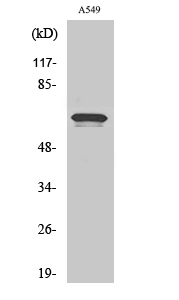HRI Polyclonal Antibody
- 产品详情
- 实验流程
- 背景知识
Application
| WB, IHC-P, IF, ICC, E |
|---|---|
| Primary Accession | Q9BQI3 |
| Reactivity | Human, Mouse, Monkey |
| Host | Rabbit |
| Clonality | Polyclonal |
| Calculated MW | 71106 Da |
| Gene ID | 27102 |
|---|---|
| Other Names | EIF2AK1; HRI; KIAA1369; Eukaryotic translation initiation factor 2-alpha kinase 1; Heme-controlled repressor; HCR; Heme-regulated eukaryotic initiation factor eIF-2-alpha kinase; Heme-regulated inhibitor; Hemin-sensitive initiation factor 2 |
| Dilution | WB~~Western Blot: 1/500 - 1/2000. Immunohistochemistry: 1/100 - 1/300. ELISA: 1/40000. Not yet tested in other applications. IHC-P~~1:50~200 IF~~1:50~200 ICC~~N/A E~~N/A |
| Format | Liquid in PBS containing 50% glycerol, 0.5% BSA and 0.09% (W/V) sodium azide. |
| Storage Conditions | -20℃ |
| Name | EIF2AK1 (HGNC:24921) |
|---|---|
| Function | Metabolic-stress sensing protein kinase that phosphorylates the alpha subunit of eukaryotic translation initiation factor 2 (EIF2S1/eIF-2-alpha) in response to various stress conditions (PubMed:32132706, PubMed:32132707, PubMed:37327776, PubMed:37550454, PubMed:38340717). Key activator of the integrated stress response (ISR) required for adaptation to various stress, such as heme deficiency, oxidative stress, osmotic shock, mitochondrial dysfunction and heat shock (PubMed:32132706, PubMed:32132707, PubMed:37327776, PubMed:37550454, PubMed:38340717). EIF2S1/eIF-2-alpha phosphorylation in response to stress converts EIF2S1/eIF-2-alpha in a global protein synthesis inhibitor, leading to a global attenuation of cap-dependent translation, while concomitantly initiating the preferential translation of ISR-specific mRNAs, such as the transcriptional activator ATF4, and hence allowing ATF4-mediated reprogramming (PubMed:32132706, PubMed:32132707, PubMed:37327776). Acts as a key sensor of heme-deficiency: in normal conditions, binds hemin via a cysteine thiolate and histidine nitrogenous coordination, leading to inhibit the protein kinase activity (By similarity). This binding occurs with moderate affinity, allowing it to sense the heme concentration within the cell: heme depletion relieves inhibition and stimulates kinase activity, activating the ISR (By similarity). Thanks to this unique heme-sensing capacity, plays a crucial role to shut off protein synthesis during acute heme-deficient conditions (By similarity). In red blood cells (RBCs), controls hemoglobin synthesis ensuring a coordinated regulation of the synthesis of its heme and globin moieties (By similarity). It thereby plays an essential protective role for RBC survival in anemias of iron deficiency (By similarity). Iron deficiency also triggers activation by full-length DELE1 (PubMed:37327776). Also activates the ISR in response to mitochondrial dysfunction: HRI/EIF2AK1 protein kinase activity is activated upon binding to the processed form of DELE1 (S-DELE1), thereby promoting the ATF4-mediated reprogramming (PubMed:32132706, PubMed:32132707). Also acts as an activator of mitophagy in response to mitochondrial damage: catalyzes phosphorylation of eIF-2-alpha (EIF2S1) following activation by S-DELE1, thereby promoting mitochondrial localization of EIF2S1, triggering PRKN-independent mitophagy (PubMed:38340717). |
For Research Use Only. Not For Use In Diagnostic Procedures.
Provided below are standard protocols that you may find useful for product applications.
BACKGROUND
Inhibits protein synthesis at the translation initiation level, in response to various stress conditions, including oxidative stress, heme deficiency, osmotic shock and heat shock. Exerts its function through the phosphorylation of EIF2S1 at 'Ser- 48' and 'Ser-51', thus preventing its recycling. Binds hemin forming a 1:1 complex through a cysteine thiolate and histidine nitrogenous coordination. This binding occurs with moderate affinity, allowing it to sense the heme concentration within the cell. Thanks to this unique heme-sensing capacity, plays a crucial role to shut off protein synthesis during acute heme-deficient conditions. In red blood cells (RBCs), controls hemoglobin synthesis ensuring a coordinated regulation of the synthesis of its heme and globin moieties. Thus plays an essential protective role for RBC survival in anemias of iron deficiency. Similarly, in hepatocytes, involved in heme-mediated translational control of CYP2B and CYP3A and possibly other hepatic P450 cytochromes. May also contain ER stress during acute heme-deficient conditions (By similarity).
终于等到您。ABCEPTA(百远生物)抗体产品。
点击下方“我要评价 ”按钮提交您的反馈信息,您的反馈和评价是我们最宝贵的财富之一,
我们将在1-3个工作日内处理您的反馈信息。
如有疑问,联系:0512-88856768 tech-china@abcepta.com.























 癌症的基本特征包括细胞增殖、血管生成、迁移、凋亡逃避机制和细胞永生等。找到癌症发生过程中这些通路的关键标记物和对应的抗体用于检测至关重要。
癌症的基本特征包括细胞增殖、血管生成、迁移、凋亡逃避机制和细胞永生等。找到癌症发生过程中这些通路的关键标记物和对应的抗体用于检测至关重要。 为您推荐一个泛素化位点预测神器——泛素化分析工具,可以为您的蛋白的泛素化位点作出预测和评分。
为您推荐一个泛素化位点预测神器——泛素化分析工具,可以为您的蛋白的泛素化位点作出预测和评分。 细胞自噬受体图形绘图工具为你的蛋白的细胞受体结合位点作出预测和评分,识别结合到自噬通路中的蛋白是非常重要的,便于让我们理解自噬在正常生理、病理过程中的作用,如发育、细胞分化、神经退化性疾病、压力条件下、感染和癌症。
细胞自噬受体图形绘图工具为你的蛋白的细胞受体结合位点作出预测和评分,识别结合到自噬通路中的蛋白是非常重要的,便于让我们理解自噬在正常生理、病理过程中的作用,如发育、细胞分化、神经退化性疾病、压力条件下、感染和癌症。






